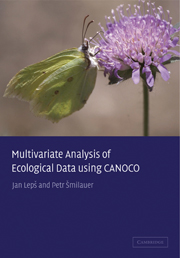Book contents
- Frontmatter
- Contents
- Preface
- 1 Introduction and data manipulation
- 2 Experimental design
- 3 Basics of gradient analysis
- 4 Using the Canoco for Windows 4.5 package
- 5 Constrained ordination and permutation tests
- 6 Similarity measures
- 7 Classification methods
- 8 Regression methods
- 9 Advanced use of ordination
- 10 Visualizing multivariate data
- 11 Case study 1: Variation in forest bird assemblages
- 12 Case study 2: Search for community composition patterns and their environmental correlates: vegetation of spring meadows
- 13 Case study 3: Separating the effects of explanatory variables
- 14 Case study 4: Evaluation of experiments in randomized complete blocks
- 15 Case study 5: Analysis of repeated observations of species composition from a factorial experiment
- 16 Case study 6: Hierarchical analysis of crayfish community variation
- 17 Case study 7: Differentiating two species and their hybrids with discriminant analysis
- Appendix A Sample datasets and projects
- Appendix B Vocabulary
- Appendix C Overview of available software
- References
- Index
16 - Case study 6: Hierarchical analysis of crayfish community variation
Published online by Cambridge University Press: 09 February 2010
- Frontmatter
- Contents
- Preface
- 1 Introduction and data manipulation
- 2 Experimental design
- 3 Basics of gradient analysis
- 4 Using the Canoco for Windows 4.5 package
- 5 Constrained ordination and permutation tests
- 6 Similarity measures
- 7 Classification methods
- 8 Regression methods
- 9 Advanced use of ordination
- 10 Visualizing multivariate data
- 11 Case study 1: Variation in forest bird assemblages
- 12 Case study 2: Search for community composition patterns and their environmental correlates: vegetation of spring meadows
- 13 Case study 3: Separating the effects of explanatory variables
- 14 Case study 4: Evaluation of experiments in randomized complete blocks
- 15 Case study 5: Analysis of repeated observations of species composition from a factorial experiment
- 16 Case study 6: Hierarchical analysis of crayfish community variation
- 17 Case study 7: Differentiating two species and their hybrids with discriminant analysis
- Appendix A Sample datasets and projects
- Appendix B Vocabulary
- Appendix C Overview of available software
- References
- Index
Summary
In this chapter, we will study the hierarchical components of variation of the crayfish community in the drainage of Spring River, north central Arkansas and south central Missouri, USA. The data were collected by Dr Camille Flinders (Flinders & Magoulick 2002, unpublished results).The statistical approach used in this study is described in Section 9.2.
Data and design
The species data consist of 567 samples of the crayfish community composition. There are 10 ‘species’, which actually represent only five cray-fish species, with each species divided into two size categories, depending on carapace length (above or below 15 mm). Note that the data matrix is quite sparse. In the 5670 data cells, there are only 834 non-zero values. Therefore, 85% of the data cells are empty! This would suggest high beta diversity and, consequently, use of a unimodal ordination method, such as CCA. There is a problem with that, however. There are 133 samples without any crayfish specimen present and such empty samples cannot be compared with the others using the chi-square distance, which is implied by unimodal ordination methods. You must, therefore, use a linear ordination method.
The sampling used for collecting data has a perfectly regular (balanced) design. The data were collected from seven different watersheds (WS). In each, three different streams (ST) were selected, and within each stream, three reaches (RE) were sampled. Each reach is (within these data) represented by three different runs (RU) and, finally, each run is represented by three different samples. This leads to the total of 567 samples = 7 WS · 3 ST · 3 RE · 3 RU · 3 replicates. These acronyms will be used, when needed, throughout this chapter.
- Type
- Chapter
- Information
- Multivariate Analysis of Ecological Data using CANOCO , pp. 236 - 244Publisher: Cambridge University PressPrint publication year: 2003



